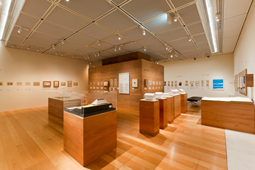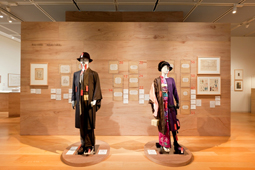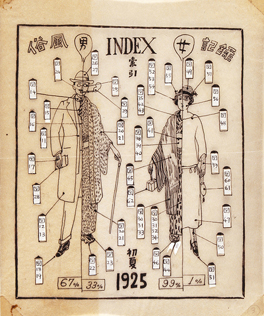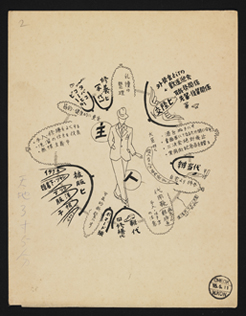 |
|
 |
| The Wajiro Kon retrospective at the Shiodome Museum is an intimate look at this keen observer's insights. |
|
Mannequins in the exhibition are clad half in Japanese and half in Western fashions of the day. |
Wajiro Kon, Lecture on Collecting at the Shiodome Museum in Shinbashi, Tokyo is a retrospective of Kon's wide-ranging work as an architect, artist, statistician, and observer of his changing world. His sketches and surveys documented the lives of people in urban and rural Japan during the 20th century. Kon's field sketchbooks, photos, architectural renderings, models, and many of his life's accoutrements are assembled in a loosely chronological sequence.
Born in 1888 in northern Japan's Aomori Prefecture, Kon moved with his family to Tokyo when he was a teenager. He entered the design program at Tokyo School of Fine Arts and graduated in 1912; in the same year he became an architectural assistant at the School of Engineering, Waseda University. Perhaps due to nostalgia for his rural childhood, in 1917 Kon joined Hakuboukai (White Thatch Society), a group of experts on traditional Japanese farmhouses. With a commission from the Ministry of Agriculture and Commerce, they carried out the first survey of rural houses throughout Japan. Kon compiled his sketches into 12 field notebooks, and the exhibition displays original works from his groundbreaking volume, Nihon no Minka (Japanese Rural Homes), originally published in 1922. While some of the watercolors and fine-line pen-and-ink and pencil drawings are carefully framed, most of his methodical original sketches are mounted loosely behind non-glare, acid-free plastic sleeves, keeping them just as they would appear in the field notebook. Tight little notes in the margins, like those on his watercolor of a snowed-in peasant's house in Niigata Prefecture, bring viewers intimately close to this observer's insights.
 |
|
 |
| Index of the Report of Ginza Fashion Survey, 1925. |
|
"Patriarch" from Vow for a New Age - Hold Your Own Maginot Line, 1940. |
In 1923 the Great Kanto Earthquake destroyed the rented house where Kon's family lived in Yotsuya, Tokyo. After relocating in the weeks that followed, Kon then surveyed areas where other refugees were congregating, such as Ueno, Shiba and Hibiya Parks. His photographs and sketches of the barracks erected there reveal his regard for social conditions and the refugees' perseverance. Often diagrammatic, his work shows the distribution of homes and shops, graphic statistical data, and illustrations of people from all classes.
Kon is credited with coining the term kogengaku or "modernology," meaning the study of phenomena of modern life. He spent years examining the relationship between customs, fashion trends, and the human body's anthropometric relationship with space. This is best demonstrated through the extensive surveys he carried out in 1925 as part of his Report of Ginza Fashion Survey. Mannequins in the exhibit don the contrasting Japanese and Western styles of the era that Kon would have encountered. On choosing Ginza for his focus Kon wrote, "I thought it would be helpful to leave [a record] today for people 50 to 100 years from now. I began with the intention of making a clear record of the life and customs of people living right in front of our eyes . . . Ginza is recognized as the great center of the customs and culture of Tokyo, which are transmitted from there to all other regions of the country."
 |
|
 |
| Watercolor of a peasant's house in Sekikawa-mura, Naka Kubiki, Niigata Prefecture, from A Journey to Northern Shinshu and Southern Echigo, 1917. |
|
A view from the window of an Aomori atelier, 1931. |
Far from focusing solely on the Japanese context, Kon also conducted a survey of villages, houses and customs on the Korean Peninsula at the request of the colonial government of Korea. In 1930 he traveled to several European cities to document their customs, people and dress. Kon is also known to have studied the decorative patterns of William Morris and John Ruskin, of the Arts and Crafts Movement and English Domestic Revival Movement respectively. He owned Owen Jones's Grammar of Ornament, a seminal design reference book that systematically and analytically traces the history and meaning of decoration. The exhibition features many of Kon's faithful reproductions of Jones's illustrations.
Kon was concerned with not only the aesthetic appeal of traditional houses but also the synthesis of many different approaches to life and culture, the distribution of resources, land cultivation, and anthropology. Through his work he promoted a new focus on the functional understanding of how people live. Kon's distinctive surveys and artistic expressiveness enjoyed some notoriety; his modernology studies were published in magazines, exhibited at the Kinokuniya bookstore, and also appreciated as art. The current exhibition is as relevant today as Kon's work was to his contemporaries. It reminds visitors to look at the details of everyday life, including things at risk of being overlooked and forgotten.
 |
|
Wajiro Kon's self-portrait photograph at a cafe in Paris, 1930.
All images courtesy of the Shiodome Museum |
|
|